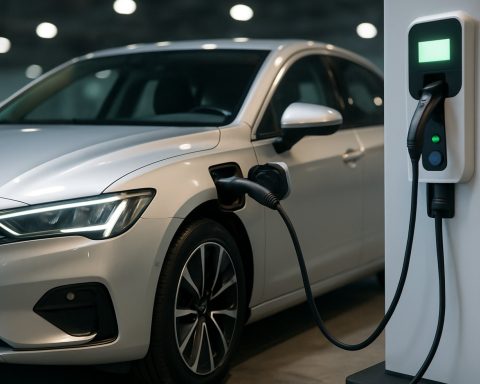- Ample is pioneering modular battery-swapping technology in Tokyo, aiming to revolutionize EV infrastructure.
- The initiative aligns with Tokyo’s goal of reducing greenhouse gas emissions by 50% by 2030.
- Ample’s system allows for battery swaps in five minutes, offering a quick and convenient alternative to traditional EV charging.
- The technology, tested successfully in Kyoto, promises minimal strain on the electrical grid.
- Collaborations with Mitsubishi Fuso and Mitsubishi Motors bolster the project’s scalability potential.
- Ample’s approach suits Tokyo’s space constraints and could transform how large commercial fleets operate.
- The model could potentially expand globally, with private EVs also benefiting from reduced charging downtime.
- This initiative positions Tokyo as a potential leader in urban sustainable transport solutions.
Beneath the neon glow of Tokyo’s bustling streets, a technological revolution quietly unfolds, promising to transform the city’s commercial fleets. Ample, a pioneer in modular battery-swapping technology, is setting the stage for a new era of electric vehicle (EV) infrastructure, with plans to implement a wide network of battery-swapping stations across the metropolis. This initiative aims to align with Tokyo’s ambitious environmental targets—specifically, a 50% reduction in greenhouse gas emissions by 2030.
Imagine a world where an EV can be “recharged” in the heartbeat of a traffic light change. Ample’s sophisticated system achieves just that, swapping out EV batteries in a mere five minutes. Priced about the same as a typical fast-food meal, this innovative approach to powering vehicles mirrors the convenience of traditional refueling stations, both in speed and simplicity. This offers an enticing alternative for urban businesses grappling with the complexities and demands of large-scale fleet operations.
The blueprint for Ample’s venture was drawn up in Kyoto, where they recently concluded a successful pilot program. Through this strategic deployment, the promise of battery swapping became tangible, delivering quick energy replenishment without overburdening the electrical grid. The collaboration with Mitsubishi Fuso Truck and Bus Corporation and Mitsubishi Motors Corporation underscored the potential to scale the technology, propelling the project forward.
Tokyo, a city synonymous with technological advancement, stands as an ideal canvas for this endeavor. Space constraints and the existing struggles with conventional charging stations make Ample’s streamlined approach particularly appealing. With its dense population and relentless energy demands, Tokyo offers a potent testbed for innovations that could potentially redefine EV logistics globally.
The ramifications of this transformation stretch far beyond city limits. As trucks and commercial vehicles begin their rhythmic dance in battery swapping stations, eyes from across the world turn toward Tokyo. The prospect of expanding this model to accommodate private EVs tantalizes car owners, suggesting a future where electric cars could dominate urban landscapes without the perennial anxieties over charging downtime and infrastructural limits.
While the journey towards a fully electrified transport network remains paved with challenges, Ample’s venture into Tokyo signifies a bold leap forward. The deployment of these cutting-edge stations hints at a broader narrative—the pursuit of sustainability through practical ingenuity. As the world watches, this ambitious push may very well position Tokyo as a beacon for urban sustainable transport solutions, setting a precedent for other megacities grappling with similar challenges.
In the shimmering heart of Japan’s capital, the future of EV charging stands poised on the brink of a breakthrough. Whether Tokyo becomes the harbinger of a new electric era remains to be seen, but the journey is certainly electrifying.
Tokyo’s Battery-Swapping Revolution: How Ample is Transforming the EV Landscape
Introduction
In the hustle and bustle of Tokyo’s streets, a silent revolution is taking place—one that could redefine the future of urban transportation. Ample’s introduction of modular battery-swapping stations is not just a nod to convenience; it’s a strategic maneuver aimed at achieving Tokyo’s ambitious environmental goals. But what does this mean for electric vehicles (EVs) and their role within the global transportation ecosystem? Let’s delve into the facts, trends, and implications of this innovative approach.
How Ample’s Battery-Swapping System Works
Ample’s battery-swapping technology is a game-changer in the EV sector. Here’s how it works:
1. Modular Design: The system utilizes swappable battery modules. Unlike traditional EVs, which integrate a permanent battery, these modules can be easily removed and replaced.
2. Speed and Efficiency: Swapping batteries takes about five minutes, comparable to a gas station refuel. This drastically reduces downtime for EV drivers and fleet operators.
3. Affordability: The cost of a swap is akin to that of a fast-food meal, making it an economically feasible option for most users.
4. Infrastructure Compatibility: The stations require minimal space and infrastructure changes, making them suitable for densely populated areas like Tokyo.
Real-World Use Cases and Industry Trends
– Commercial Fleets: Companies with large fleets, such as delivery and logistics firms, benefit significantly from reduced refueling time and increased vehicle uptime.
– Growing Urban Markets: Cities worldwide are looking to adopt similar systems as part of their smart city developments, with a focus on sustainability and reducing carbon footprints.
– Expansion Potential: While currently focusing on commercial fleets, there’s a substantial market opportunity for private EV owners, paving the way for broader adoption.
Features, Specs & Pricing
– Capacity: Each station can perform multiple swaps simultaneously, minimizing wait times.
– Integration: Compatible with existing EV models from prominent manufacturers, thanks to partnerships with industry leaders like Mitsubishi.
– Cost Model: Pricing strategies are competitive, aiming to undercut traditional charging fees while offering subscription models for frequent users.
Security & Sustainability
– Grid Management: The technology relieves stress on the electric grid by avoiding peak charging times, as reported in the Kyoto pilot program.
– Environmental Impact: This initiative supports Tokyo’s goal of a 50% reduction in greenhouse gas emissions by 2030.
Controversies & Limitations
– Initial Investment: High upfront costs for infrastructure development, though they are offset by long-term savings and environmental benefits.
– Adoption Rate: The pace at which consumers and businesses embrace the technology depends on localized factors, such as government incentives and market readiness.
Market Forecast and Industry Predictions
Industry experts predict a surge in battery-swapping services, especially in urban centers. According to a report by Bloomberg New Energy Finance, the battery-swapping market could grow substantially once key logistical barriers are addressed.
Actionable Recommendations
1. For Fleet Operators: Consider integrating Ample’s swapping system to enhance efficiency and reduce operational costs.
2. For Policy Makers: Promote incentives for battery-swapping technology to accelerate urban sustainability goals.
3. For Consumers: Monitor the expansion of these services, as they can drastically shorten recharging times and offer cost savings.
Conclusion
Ample’s battery-swapping technology is an electrifying development in the world of urban transportation. As cities like Tokyo pave the way for sustainable innovations, other urban centers will look to replicate this model. Embracing such cutting-edge technology not only promises a greener future but also a more efficient one.
For additional insights into sustainable transport solutions, visit Ample.







